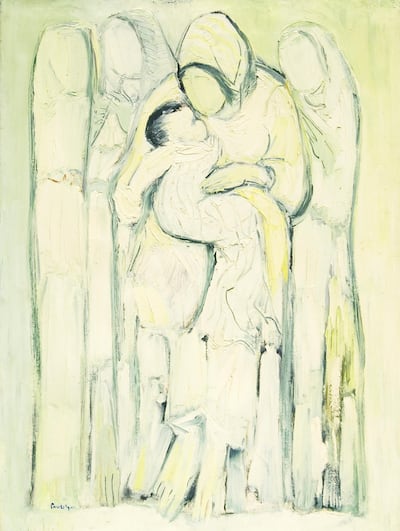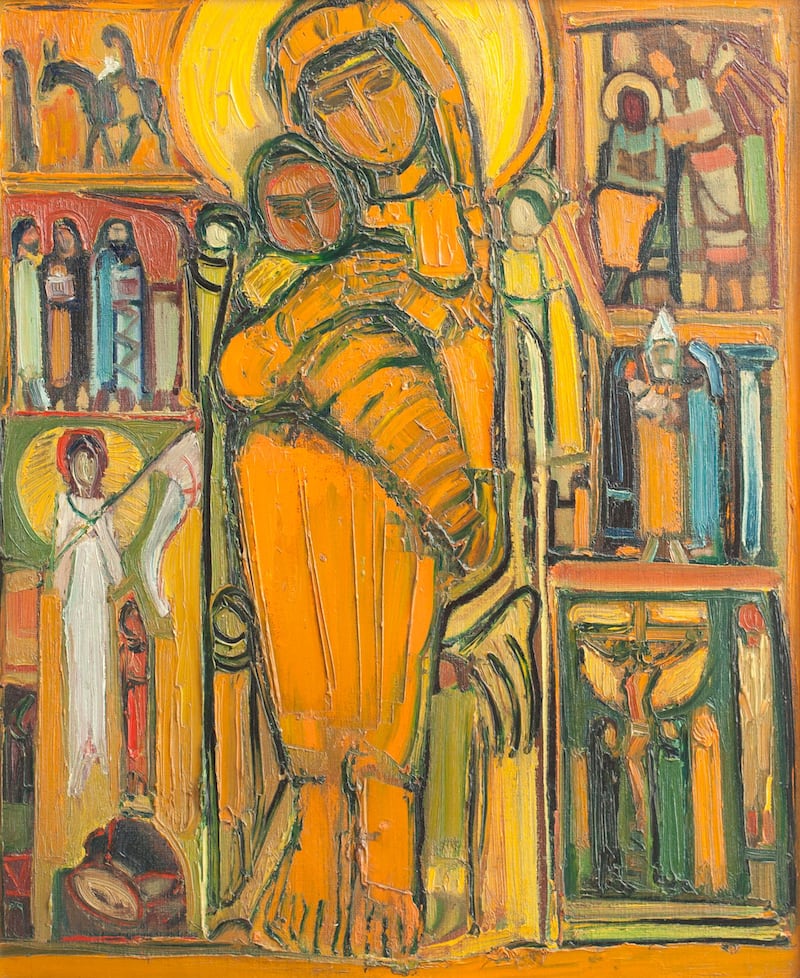Paul Guiragossian's show at the Barjeel Art Foundation in Sharjah feels intimate, like a family affair. Organised on the 25th anniversary of Guiragossian's death, the exhibition, curated by Sheikha Maisa Al Qassimi, looks at the Beiruti artist's paintings as they developed from the 1950s to the 1990s, passing through abstraction and figuration, in thick paint-handling or depicting biblical motifs, with people as the ever-present subject.
A mother cradles a young child as faceless women stand behind her. A woman lights an oil lamp. One strums the oud. Later in his career, these figures become abstracted: a recurrent motif is that of vertical stripes of paint, in which a few angled strokes are enough to suggest the outlines of faces, transforming the image in one fell swoop from an assemblage of colour into a picture of standing silhouettes, waiting, perhaps, or just watching.
'He grew up with multiple cultures'
Guiragossian was born in 1926 to Armenian parents who were survivors of the genocide in the First World War. He settled in Beirut in late 1947, making the city his home. (The city returned the favour: when he died, it honoured him with a state funeral.) He lived first within Lebanon's small Armenian community and later among its intellectuals, speaking Armenian, Arabic and French, in addition to English, Italian, Hebrew and others, according to his daughter. He was a consummate multiculturalist in a city known for its great diversity.
“He grew up with multiple cultures,” says Manuella Guiragossian – who advised on the show along with Barjeel curator Mandy Merzaban – of her father. “He had a real interest in ancient civilisations and educated himself about all of them. In his lectures, you see he goes into art history not only of the West, but also of the East, and then he gives you his own analytical fusion, if you like, of all of these civilisations and movements coming together.”
Guiragossian was educated in a convent, and his work ranged from religious motifs to the kind of colourful abstraction that marks much of Arab Modernism, and he moved between abstraction and representation throughout his life. While he is best known for the images of standing figures, this show, Paul Guiragossian: Testimonies of Existence, includes a number of works from early in his career, in which the portrayal of families is crucial, often centring on the dyad of mother and child. Madonna and Child – dating circa 1957 and the oldest work in this show – is executed in a sombre, golden palette of Byzantine icons.
_________________
Read more:
Sultan Al Qassemi: Taking a 'Warrior’s Break'
'Syria: A Conflict Explored' exhibition brings to light harsh realities of war
eL Seed to create mural near Abu Dhabi Mall
_________________
He never moves wholly away from the scene of early motherhood, although it later appears secularised, as in The New Born (1969) or the extraordinary Le Centre du Monde (circa 1983), an image of almost pure placidity and hope. The lack of features in the women in the background of the latter seem only a step away from the abstract stripes of silhouettes.
A video included in the exhibition suggests Guiragossian's painting and drawing practice as part of his way of being, or his way of connecting with the world. In 1991, an amateur filmmaker followed him for a day around Beirut. Visiting a building where Guiragossian used to live, they happen to come across two women standing in a doorway, their young children all around them, one holding a baby who has just fallen asleep. He asks them to stop and pulls out his sketchbook and begins drawing: the woman with the baby, the two women with the children, then the children one by one, the everyday encounter turning rapidly into time-honoured, black-inked representation of the theme of motherhood.
His 'sheer empathy'
Sheikha Al Qassimi says that in her research for the show, she came across an interview where Guiragossian talks about his placement of bodies on canvas. “I let them float on a canvas,” she recalls him saying. “I don’t draw a land, I don’t draw a sky, so you don’t know where they are.”
For Sheikha Al Qassimi, Guiragossian’s feeling of displacement and the impact of the Armenian genocide provide his work with a particular resonance in the current context, as artists again confront situations of forced migration. “I made sure that we had a number of earlier works, from the 1960s,” she says about her selection of the work. “There was a moment when he moved to Beirut, to Bourj Hammoud, and he was there around a lot of displaced people, Armenian refugees who lived through refugee camps. It’s so relevant today to bring that back up.”

The exhibition suggests a political dimension that appears born of – if this phrase isn’t too heavy – sheer empathy. “When I was going through the archives,” Sheikha Al Qassimi says, “there was an interview – and he was very passionate about this, he sounded very serious. He said: ‘The first incident that happens in India where there’s no food, I’m the first person to feel hunger.’ I just got goosebumps and I thought to myself, he was revolutionary. He was an activist through his painting. He even painted political posters, which many people don’t know about. He was really affected by war, and the sense of displacement and not knowing where he was from and where he belonged.”
The works in the exhibition are drawn from the collections of those in the UAE, in what Manuella calls a tribute to the UAE's support for his work. The selection criterion means this show is not a full retrospective, and instead reflects the increasing engagement with Arab Modernism in the country.
The Emirates Fine Art Society knew of his work, Manuella Guiragossian says, and Green Art Gallery, one of the first major commercial galleries in Dubai, held a show in 2003 from which a number of paintings were bought locally.
The Paul Guiragossian Foundation is also publishing this year the first comprehensive monograph of his work, edited by Sam Berdaouil and Till Fellrath – who curated a 2013 exhibition of his work in Beirut – which they are launching next month at Art Dubai.
Sheikha Al Qassimi says there was amazing support from the people they contacted for loans. "Every collector we spoke to had two to three works, and all of a sudden we had about 45 works just in the UAE. We had a variety of everything, and decided to limit it to paintings, because a lot of collectors had works on paper as well." The show sketches his important themes. "You see the evolution of his work, although we didn't hang it chronologically," she says. "He is such an important figure in modern Arab art history, and there needs to be more research and scholarship on his work."
Paul Guiragossian: Testimonies of Existence is on at the Barjeel Art Foundation, Level Two Maraya Art Centre,
Al Qasba, Sharjah, UAE until April 28. barjeelartfoundation.org






